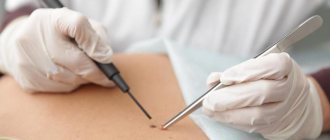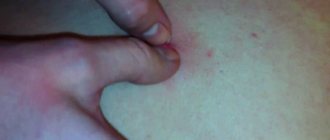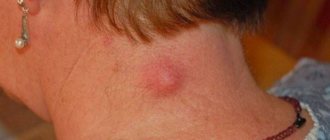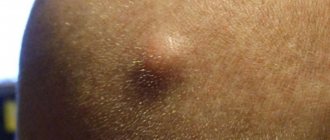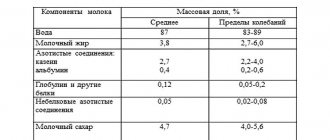Human papillomavirus, penetrating the female body, can provoke papillary growth in the excretory ducts of the mammary glands. These benign formations - intraductal papillomas - are a consequence of hormonal imbalance in combination with papillomavirus infection. They appear in women of different ages and are localized in one or both mammary glands. However, as a rule, such a tumor increases the risk of developing breast cancer.
- 2 Types of cystadenopapilloma
- 3 Factors in the development of cystadenopapilloma
- 4 Symptoms and signs
- 5 Diagnosis of cystadenopapilloma
- 6 Treatment of papillary tumor
6.1 Drug therapy
- 6.2 Surgery and rehabilitation after surgery
Discharge from the mammary gland
When pressing on the nipple, a woman may have different discharge patterns. Sometimes they spontaneously leave stains on laundry.
Discharge from nipples
These photos show light or slightly cloudy scanty whitish discharge - they are not a pathology. Moreover, their volume and color are the same on the right and left.
Discharge from the nipples of the mammary glands
Light transparent, or brown, yellow discharge is rarely a manifestation of papilloma.
If they are symmetrical on the right and left in volume and color but abundant, they are most often associated with hormonal changes (ovaries or thyroid gland).
Nipple discharge during
Nipple discharge may occur during orgasm. This is due to muscle contraction and squeezing out contents from the ducts. Another thing is why there is so much of this content that it does not remain in the ducts, but is squeezed out. More often this is due to hormonal changes (gynecology, thyroid gland or excess intake of hormones from food - broiler poultry, fish, semi-finished broiler meat products).
Prevention
The first thing doctors recommend is:
- monthly self-examination and regular appointment with a mammologist;
- It is important to remember that after 40 years a woman should be examined by a doctor at least once a year;
- Of course, it is necessary to promptly treat any deviations in the sexual sphere and prevent exacerbation of diseases;
- During puberty, it is important to ensure that the body does not become overcooled;
- Fight excess weight. Since kilograms lying “on top” often contribute to disruption of many body functions, including the endocrine system, which leads to hormonal imbalances;
- If a woman is diagnosed with mastopathy, she is at risk, which means she should be regularly examined and treated with medication, unless another method is prescribed.
You need to know that any chest pain is dangerous! Discharge and compaction are not the norm! The earlier the disease is detected, the more effective the treatment will be, and the painful consequences will be minimized. A healthy long life depends on attention and control.
Nipple discharge
A clear sign of breast duct papilloma is bloody discharge from the nipple when pressed.
Brown discharge from the nipple
Brown or rusty discharge from the breast ducts - may appear as stains on laundry. The rusty color is due to destroyed red blood cells. This is also a sign of bleeding.
| Photo of a nipple with bloody discharge due to ductal papilloma of the mammary gland (cystadenopapilloma) |
Breast papilloma surgery
Treatment of cystadenopapilloma is surgical. The operation consists of removing all the ducts of the mammary gland (Koenig operation or ductectomy). The patient will not be able to breastfeed after this operation. Such an operation is possible under a compulsory medical insurance or voluntary medical insurance policy.
For nulliparous women, or in cases where our patient plans to give birth and breastfeeding in the future, we offer Babcock surgery - this is when we find, isolate and remove only the duct with papilloma . In this way, it is possible to preserve the possibility of lactation in a woman through other (unremoved) ducts of this mammary gland.
Physiology of the disease
The mammary glands consist of several types of tissue: glandular, fatty and connective. One mammary gland is divided into 15-20 small lobes by connective tissue. These shares are divided into even smaller ones. The separation of the lobular parts occurs due to adipose tissue. Adipose tissue supports the gland, forming a “cushion”. It is she who determines the shape and volume of the breast.
Glandular tissue consists of small glands called lacteal glands. Each of them is a bundle of tubes that end in alveoli on one side and nipples on the other. The alveoli and ducts inside are lined with an epithelial layer. When infected with papillomavirus, benign neoplasms are formed from the cells of the lining epithelium - papillary tumors. They can be located singly in the internal lumen of the duct or grow, increasing both in size and quantity.
The formations are attached to the epithelium by a thin stalk, through the fibers of which blood vessels pass. Therefore, they can bleed at the slightest damage. In mammology, this disease is called intraductal papilloma of the mammary gland.
The neoplasms have a dense structure, clear boundaries, and are oblong in shape. When they are injured, in some cases tissue necrosis may develop, the danger of which lies in the development of complications that threaten the woman’s life.
Cystadenopapilloma
Cystadenopapilloma is a papilloma of the mammary gland duct, but when it is located far from the nipple and discharge accumulates in the thickness of the mammary gland, without exiting through the nipple. This papilloma forms a breast cyst with growths.
| Ultrasound signs of peripheral cystadenopapilloma. The papilloma was located in the duct far from the nipple. Discharge (having no outlet) accumulated around her. Read more about such cysts HERE |
Bloody discharge from the nipple
Blood discharge from the nipple of the mammary gland also occurs with cancer. Therefore, it is imperative to perform their microscopic examination.
If the papilloma is inside the cyst, but there is no discharge from the nipple, a puncture (puncture) of the cyst is performed to examine its contents.
The specialists of our Center can take nipple discharge for analysis and perform a biopsy of cystadenopapilloma on the same day of your consultation.
Treatment methods
Intraductal papilloma is not able to resolve. Therefore, patients should not hope that the problem will go away on its own.
Doctors consider cystadenopapilloma as a precancerous condition.
Thus, the only treatment for intraductal papilloma is surgery to remove the formation.
Surgery for intraductal papilloma
The surgical method is chosen by the surgeon based on the test results.
The only effective treatment for intraductal papilloma is surgery to remove the formation.
The operation can be performed in the following ways:
- Sectoral resection. Surgical intervention involves excision of a certain area of the gland. The procedure is used only for single papillomas. The operation is performed under general anesthesia. The surgeon makes a small incision along the very edge of the areola. This protects the breasts from deformation. The pathological part of the duct (which contains papilloma and blood clots) is removed. The wound is sutured with a cosmetic suture. A week later it is removed.
- Electrocoagulation. This method can only be used for papilloma formed on the areola. Electrocoagulation involves removing the formation using an electric current.
- Laser surgery. The most gentle method of surgical intervention. The laser is used to remove papillomas localized on the nipple.
- Removal of the mammary gland. This method is used for multiple papillomas that are located in the peripheral ducts.
Rehabilitation period
After the operation, the excised tumor is sent for histology. If malignant degeneration is detected, the woman is prescribed radiation and chemotherapy.
During the rehabilitation period, the following measures are recommended for the patient:
- Daily dressings. The medical staff carefully treats the wound and monitors its condition. After 7 days, the sutures are removed.
- Physiotherapy. Special physical exercises are recommended. They improve muscle tone, activate lymph flow and blood circulation. Gymnastics reduces the likelihood of developing inflammation and swelling of tissues.
- Psychological help. A woman who has undergone a mastectomy (breast removal) may need specialist support.
Sometimes women who have undergone breast surgery need the help of a psychologist
- Avoiding hot baths. It is recommended to replace such events with a warm shower. Doctors advise avoiding visiting saunas and steam baths.
Drug therapy
During rehabilitation, a woman must be prescribed drug therapy. It is aimed at supporting the body and promoting its recovery.
The patient is recommended:
- Painkillers. Such drugs are prescribed immediately after surgery. After all, the anesthesia will wear off, and the patient may experience severe discomfort. May be recommended:
- Ketonal;
- Diclofenac;
- Ibuprofen;
- Nurofen.
- Immunomodulatory drugs. An excellent remedy that also has an anti-inflammatory effect is Wobenzym.
- Medicines for correcting hyperplastic pathological processes in the breast. A woman is recommended:
- Indinol;
- Intrinol;
- Bromocriptine;
- Progestogel.
- Antibiotics. If there is an inflammatory process, antibacterial drugs are prescribed.
- Homeopathic medicines. These medications help restore the body and prevent relapses. The following drugs are effective:
- Mastodinon;
- Cyclodinone.
- Vitamin complexes. During the postoperative period, a woman especially needs vitamins E, A, C. The following complexes are useful:
- Duovit;
- Alphabet;
- Vitrum.
- Oral contraceptives. Such drugs are prescribed to normalize hormonal levels in the body. Drugs are selected based on tests. May be assigned:
- Novinet;
- Silest;
- Jess;
- Trisiston;
- Miniziston;
- Trinovum.
Folk remedies for intraductal papilloma are ineffective. Therefore, non-traditional methods of therapy are not used for this pathology.
Medications - gallery
Ketonal eliminates pain after surgery
Wobenzym is an immunomodulator that provides an anti-inflammatory effect
Indinol corrects hyperplastic processes in the mammary gland
Mastodinon helps restore the body
The alphabet saturates the body with vitamins and minerals
Novinet normalizes hormonal levels
Ductography
Ductography is used to detect papilloma in the mammary duct. To do this, a thin tube (blunt needle) is inserted into the duct (from which discharge is detected), through which a contrast agent is injected into the duct. This drug fills the ducts and “flows around” the papilloma - it becomes noticeable. For small papillomas, the introduction of contrast has a cauterizing effect on them and the discharge may stop. If they appear again, surgery is indicated.
Ductography is a mammography with contrast filling of the breast ducts.


